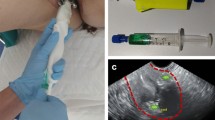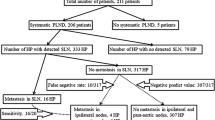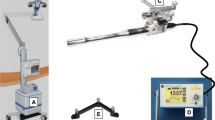Abstract
Purpose
The purpose of this study was to assess the feasibility of sentinel lymph node (SLN) detection in endometrial cancer patients with a dual-tracer procedure after hysteroscopic peritumoural injection.
Methods
Twenty-six women with previously untreated endometrial adenocarcinoma underwent the hysteroscopic injection of 111 MBq 99mTc-Nanocoll and blue dye administered subendometrially around the lesion. On the same day, all 26 patients underwent lymphoscintigraphy, followed 3–4 h later by hysterotomy with bilateral salpingo-oophorectomy and pelvic lymphadenectomy. Para-aortic lymphadenectomy was also performed in cases of either serous or papillary carcinoma (n=7/26). All SLNs were removed and examined with haematoxylin and eosin staining and immunohistochemical techniques.
Results
The procedure was well tolerated by patients, only two experiencing transient vagal symptoms. The sensitivity of this technique for correct identification of SLNs was 100%. Lymph node metastases were found in 4 out of the 26 patients (15%), bilaterally in the external iliac region (n=1), unilaterally in the external iliac region (n=1), unilaterally in the common iliac region (n=1) and unilaterally in the para-aortic region (n=1). In all four cases, nodal metastases were located within SLNs detected by lymphoscintigraphy. Only 10 of the 26 patients (38%) had significant blue dye staining. All blue-stained SLNs were radioactive.
Conclusion
In patients with endometrial cancer, it is feasible to use lymphatic mapping and SLN biopsy to define the topographic distribution of the lymphatic network and also to accurately detect lumbo-aortic and pelvic metastases within SLNs. In the majority of patients with early stage endometrial cancer, this procedure may avoid unnecessary radical pelvic lymphadenectomy. It may also guide para-aortic lymph node dissection on the basis of the SLN status.


Similar content being viewed by others
References
Estourgie SH, Nieweg OE, Valdes Olmos RA, Hoefnagel CA, Kroon BB. Review and evaluation of sentinel node procedures in 250 melanoma patients with a median follow-up of 6 years. Ann Surg Oncol 2003;10:681–8.
Veronesi U, Paganelli G, Viale G, Luini A, Zurrida S, Galimberti V, et al. A randomized comparison of sentinel-node biopsy with routine axillary dissection in breast cancer. N Engl J Med 2003;349:546–53.
Makar AP, Scheistroen M, van den Weyngaert D, Trope CG. Surgical management of stage I and stage II vulvar cancer: the role of the sentinel node biopsy. Review of literature. Int J Gynecol Cancer 2001;11:255–62.
Dargent D, Martin X, Mathevet P. Laparoscopic assessment of the sentinel lymph node in early stage cervical cancer. Gynecol Oncol 2000;79:411–5.
Lurain JR, Rice BL, Rademaker AW, Poggensee LE, Schink JC, Miller DS. Prognostic factors associated with recurrence in clinical stage I adenocarcinoma of the endometrium. Obstet Gynecol 1991;78:63–9.
Belinson JL, Lee KK, Badger GJ, Pretorius RG, Jarrell MA. Clinical stage I adenocarcinoma of the endometrium—analysis of recurrences and the potential benefit of staging lymphadenectomy. Gynecol Oncol 1992;44:17–23.
Benedetti Panici PL, Scambia G, Baiocchi G, Greggi S, Mancuso S. Technique and feasibility of radical para-aortic and pelvic lymphadenectomy for gynaecologic malignancies: a prospective study. Int J Gynecol Cancer 1991;1:133–40.
Burke TW, Levenback C, Tornos C, Morris M, Wharton JT, Gershenson DM. Intraabdominal lymphatic mapping to direct selective pelvic and paraaortic lymphadenectomy in women with high-risk endometrial cancer: result of a pilot study. Gynecol Oncol 1996;62:169–73.
Pelosi E, Arena V, Baudino B, Belló M, Giusti M, Gargiulo T, et al. Pre-operative lymphatic mapping and intra-operative sentinel lymph node detection in early stage endometrial cancer. Nucl Med Commun 2003;24(9):971–5.
Holub Z, Jabor A, Kliment L. Comparison of two procedures for sentinel lymph node detection in patients with endometrial cancer: a pilot study. Eur J Gynecol Oncol 2002;23:53–7.
Zambo K, Koppan M, Paal A, Schmidt E, Tinneberg HR, Bodis J. Sentinel lymph nodes in gynaecological malignancies: frontline between TNM and clinical staging system? Eur J Nucl Med Mol Imaging 2003;30(12):1684–8.
Fersis N, Gruber I, Relakis K, Friedrich M, Becker S, Wallwiener D, et al. Sentinel node identification and intraoperative lymphatic mapping. First results of a pilot study in patients with endometrial cancer. Eur J Gynaecol Oncol 2004;25(3):339–42.
Gargiulo T, Giusti M, Bottero A, Leo L, Brokaj L, Armellino F, et al. Sentinel lymph node (SLN) laparoscopic assessment early stage in endometrial cancer. Minerva Ginecol 2003;55(3):259–62.
Barranger E, Cortez A, Grahek D, Callard P, Uzan S, Darai E. Laparoscopic sentinel node procedure using a combination of patent blue and radiocolloid in women with endometrial cancer. Ann Surg Oncol 2004;11:344–9.
Niikura H, Okamura C, Utsunomiya H, Yoshinaga K, Akahira J, Ito K, Yaegashi N. Sentinel lymph node detection in patients with endometrial cancer. Gynecol Oncol 2004;92:669–74.
Veronesi U, Paganelli G, Viale G, Luini A, Zurrida S, Galimberti V, et al. A randomized comparison of sentinel-node biopsy with routine axillary dissection in breast cancer. N Engl J Med 2003;349:546–53.
Glass EC, Essner R, Morton DL. Kinetics of three lymphoscintigraphic agents in patients with melanoma. J Nucl Med 1998;38:1185–90.
Morton DL, Wen DR, Wong JH, Economu JS, Cagle LA, Storm FK, et al. Technical details of intraoperative lymphatic mapping for early stage melanoma. Arch Surg 1992;127:392–9.
Giuliano AE, Kirgan DM, Geunther JM, Morton DL. Lymphatic mapping and sentinel lymphadenectomy for breast cancer. Ann Surg 1994;220:391–401.
Alex JC, Krag DN. Gamma probe-guide localization of lymph nodes. Surg Oncol 1993;2:137–43.
Alex JC, Weaver DL, Fairbank JT, Rankin BS, Krag DN. Gamma-probe-guided lymph node localization in malignant melanoma. Surg Oncol 1993;2:303–8.
Van der Veen H, Hoekstra OS, Paul MA, Cuesta MA, Meijer S. Gamma probe-guided sentinel node biopsy to select patients with melanoma for lymphadenectomy. Br J Surg 1994;81:1769–70.
Kapteijn BA, Nieweg OE, Liem I, Mooi WJ, Balm AJ, Muller SH, et al. Localizing the sentinel node in cutaneous melanoma: gamma-probe detection versus blue-dye. Ann Surg Oncol 1997;4:156–60.
Alazraki N, Glass EC, Castronovo F, Olmos RA, Podoloff D. Procedure guideline for lymphoscintigraphy and the use of intraoperative gamma probe for sentinel lymph node localization in melanoma of intermediate thickness 1.0. J Nucl Med 2002;43(10):1414–8.
Zanzonico P, Heller S. The intra-operative gamma probe: basic principles and choices available. Semin Nucl Med 2000;30:33–48.
Kopp J, Wengenmair H, Vogt H, Heidenreich P. Intra-operative gamma-probe: performance of commercially available systems- a comparison. Eur J Nucl Med 1999;26 Suppl 4:S59, S.03.04.
FIGO news. Corpus cancer staging. Int J Obstet 1989;28:190.
Obermair A, Geramou M, Gucer F, Denison U, Graf AH, Kapshammer E, et al. Does hysteroscopy facilitate tumor cell dissemination? Cancer 2000;88:139–43.
Selvaggi L, Cormio G, Ceci O, Loverro G, Cazzolla A, Bettocchi S. Hysteroscopy does not increase the risk of microscopic extrauterine spread in endometrial carcinoma. Int J Gynecol Cancer 2003;13:223–7.
Baker VL, Adamson GD. Threshold intrauterine perfusion pressures for intraperitoneal spill during hydrotubation and correlation with tubal adhesive disease. Fertil Steril 1995;64:1066–9.
Kasamatsu T, Onda T, Katsumata N, Sawada M, Yamada T, Tsunematsu R, et al. Prognostic significance of positive peritoneal cytology in endometrial carcinoma confined to the uterus. Br J Cancer 2003;88:245–50.
Acknowledgements
The authors appreciate the assistance of the technologists Mrs. Monica Testoni and Mrs. Elena Fraigola in the standardisation of the technical procedures. The authors are grateful to Mrs. Annaluisa De Simone Sorrentino for her help in preparing this manuscript.
Author information
Authors and Affiliations
Corresponding author
Rights and permissions
About this article
Cite this article
Maccauro, M., Lucignani, G., Aliberti, G. et al. Sentinel lymph node detection following the hysteroscopic peritumoural injection of 99mTc-labelled albumin nanocolloid in endometrial cancer. Eur J Nucl Med Mol Imaging 32, 569–574 (2005). https://doi.org/10.1007/s00259-004-1709-4
Received:
Accepted:
Published:
Issue Date:
DOI: https://doi.org/10.1007/s00259-004-1709-4




